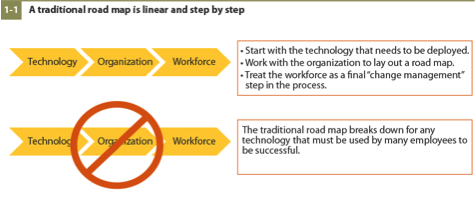Presenting Four Cases That Can Help You Transform Your Organization Into A Social And Collaborative Business
My colleague Ted Schadler and I recently completed a six month investigation into social business and collaborative transformation. As the title of the report — The Road To Social Business Starts With A Burning Platform — suggests, these complex workforce programs work when there is a compelling motivation to change behaviors among employees, business sponsors, and IT. Our study shows that this success breaks the age-old habits of technology deployment. It's not a linear roadmap; it's an interactive process that requires flexibility and adaptability from all three groups, as the diagram below shows.

We started by looking for programs with a multi-quarter or multi-year story of success and overcoming barriers and found four companies willing to go deep on their initiatives:
- Kindred Healthcare mobilized information capture and sharing for their sales force with iPads and salesforce.com. Before the iPad program, "clinical liaison" salespeople worked inconsistently with paper-based sales tools and manual processes, and sales executives had little data on what content and what approaches worked best. With the help of Appirio, clinical liaisons now use video content to educate patients, share information immediately with patient families via email, and prepare for meetings with maps and medical staff information.
- SAS built a social collaboration tool called "The Hub" on Socialcast technology to provide employees a secure place to have business conversations. The Hub now boasts more than 900 employee-created groups that give workers access to information and connect them to people across the organization — including executives — to get things done.
- The State of Minnesota's Office of Enterprise Technology rolled out Microsoft Office 365, the cloud-hosted collaboration platform, to 35,000 government workers, enabling state agencies to easily work with one another through a common collaboration platform. It also freed the IT department to partner with the business to help business leaders creatively address problems, instead of simply "rationing constrained IT resources."
- Symantec created, as part of a broader social media initiative, a customer listening command center around salesforce.com's Radian6 technology. The system, manned five days a week by staff in nine different time zones, funnels social media commentary to workers in nine different groups across Symantec based on a sophisticated classification scheme. This lets Symantec react more quickly to customer needs and work toward improving the customer experience.
We will write about what we learned and present some details on these case studies in future posts.